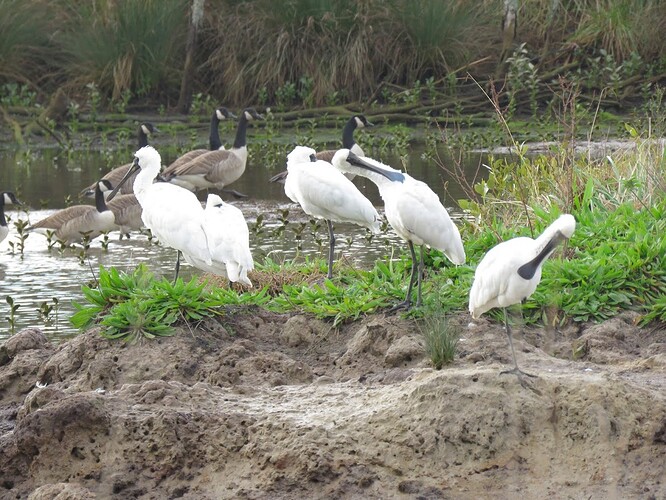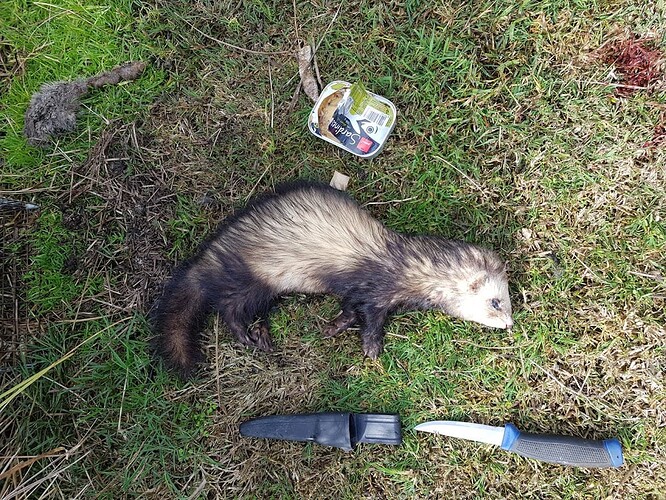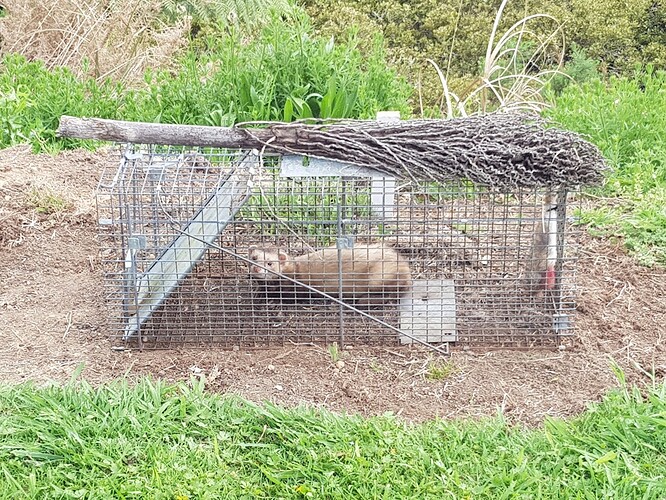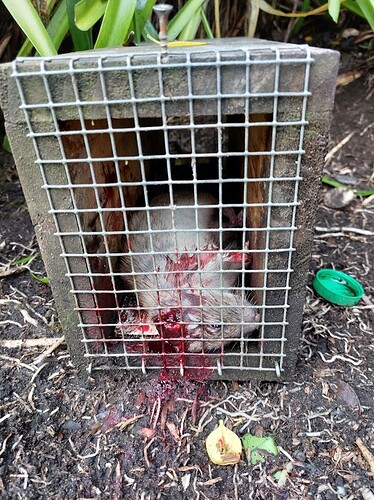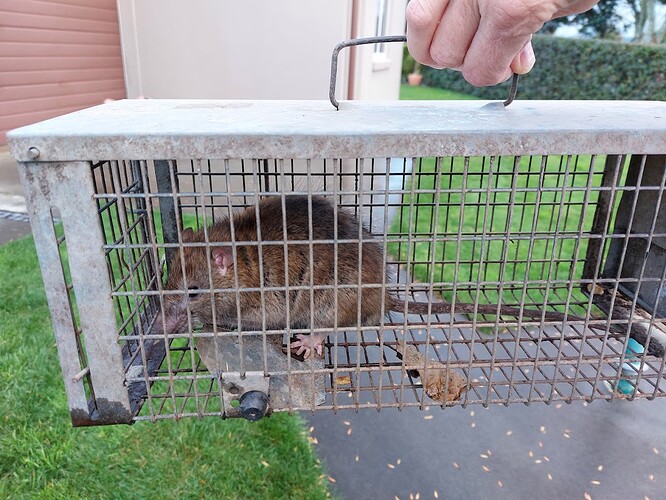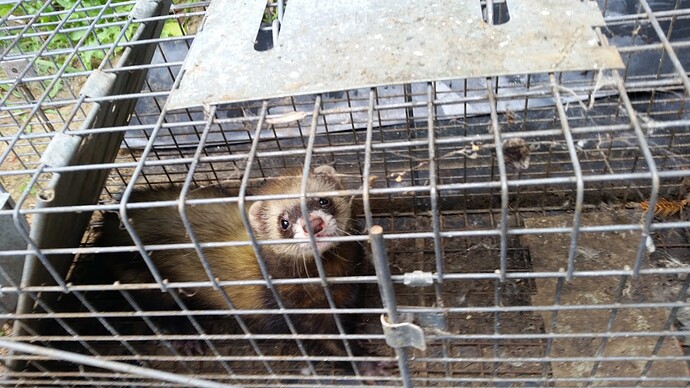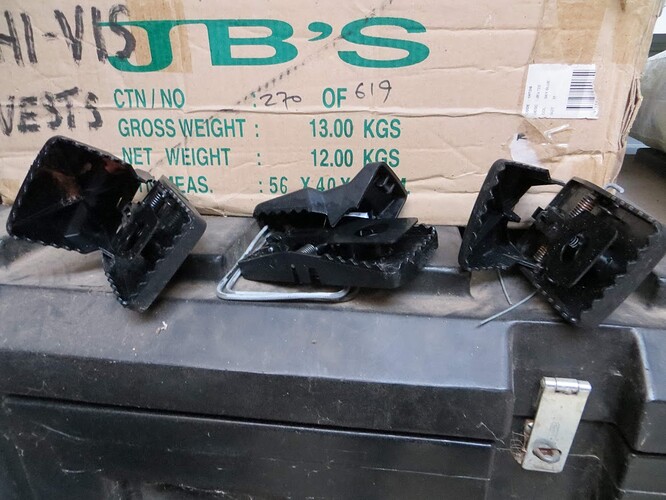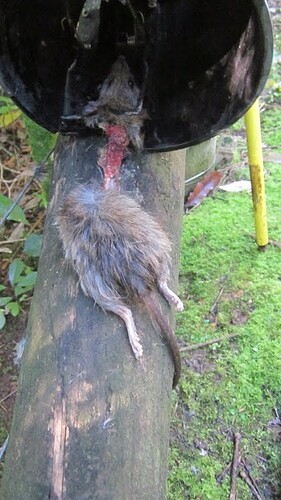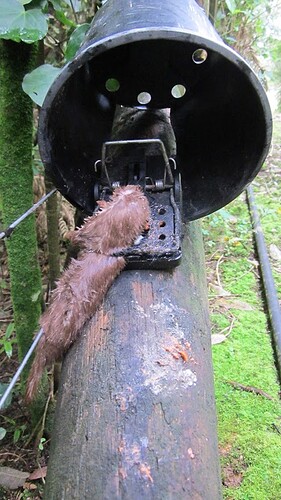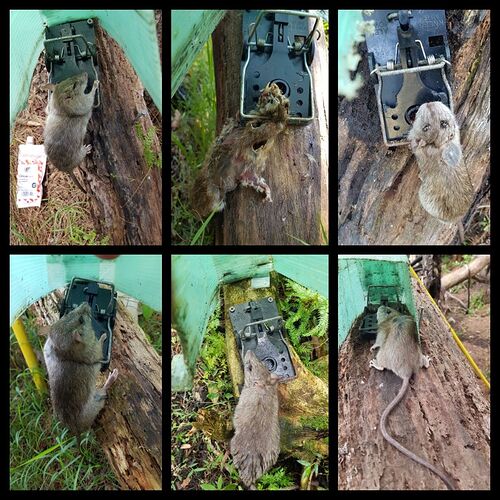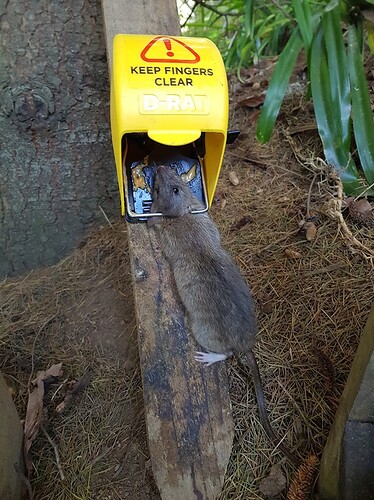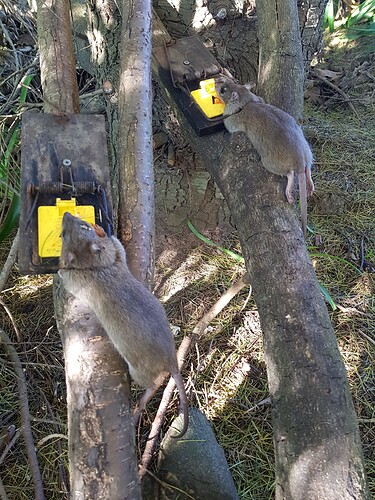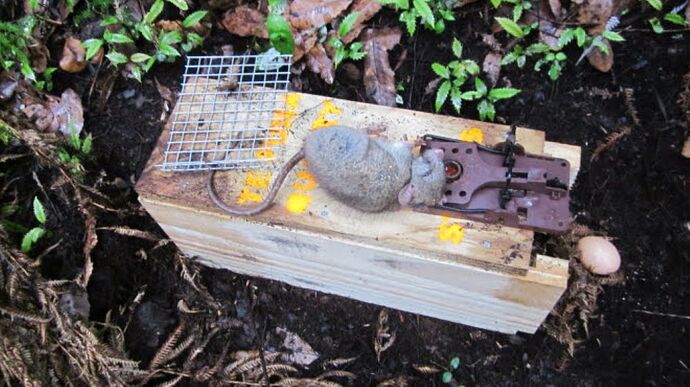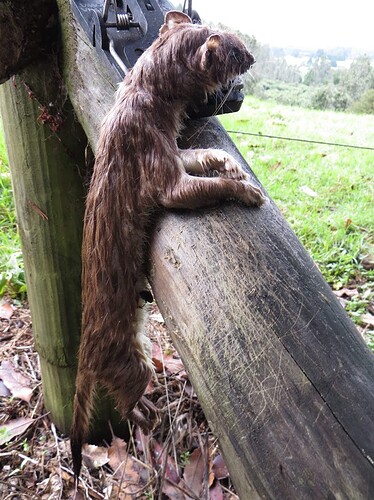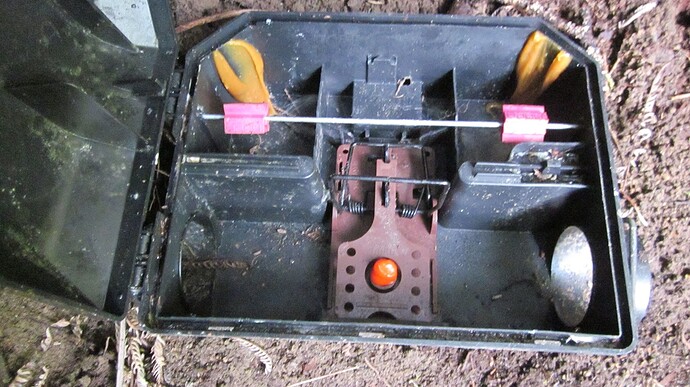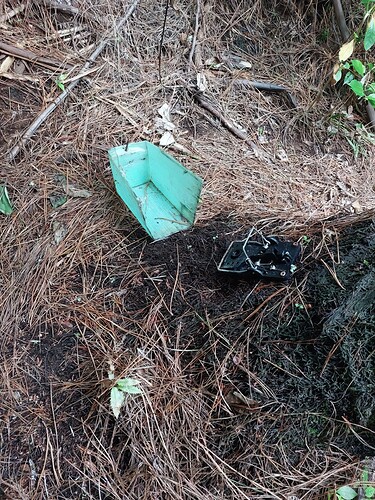When there are numerous types of birds that live around the harbour estuary – along with rabbits that love the residential gardens - there are going to be a variety of predators that enjoy the environment. A flock of up to twenty Royal Spoonbills live here, large numbers of Canadas and a variety of ducks.
In our case lots of Norway rats, occasional ferrets, hogs and residents cats – which are sacred. The Norways have short swimming distances and tidal mudflats to move around so they just keep on coming.
An occasional session with a cage will trip up the hogs and ferrets. I got one family of seven ferrets in about a month before they moved on.
Some of the Norways are huge – a Victor Pro will often stun them but not always kill them in the trap – they often bleed out in the other end of the box. The caged animals are always shot.
Dumb question. How do you shoot the stoat, and what weapon do you use? I have never done this (in a cage) myself and am concerned about ricochets, or missing. I had possum caught in a DOC 200 once…not easy to dispatch it!
Good question Dan – I use a .22 and subsonic ammo – they are not timid so usually taking a close look – barrel between the wires and mostly a head shot. They are beautiful animals so I often feel a bit sad – but they have to go. You will see a bullet hole in the foot treadle in the previous picture – my neighbour did the job for me and did a top down shot.
It is an ugly business when you get a cat or a hog in a doc200 and you have to finish them off – a hammer is useful.
Hi Dan, I have a door at each end cage trap which is my most successful trap. I have three other types. Draw back with live capture is having to finish the animal off. I have a .177 slug gun with the advantages are it’s quiet and you don’t need a fire arms licence, cheap to. Lot less likely to have ricochets or damaging the trap, shoot large animals like possums in the ear as it is more reliable to get the desired instant kill. Hope this is useful to you. Mark
Great work on the ferrets!
The brown rats here are often the size of my forearm, weighing up to 500g. Some of them can be very difficult to trap. Winter after winter, they burrow under our deck, seeking shelter while they attempt to chew their way up to the pantry.
The smooth kill-bar on Victors and other snap-traps, allow some predators to pull or shake themselves free. To make these traps more humane and reduce escapes, you can drill nails or screws at the front of the trap to impale predators. Also, since I mounted down my snap-traps with screws, they’ve become both more humane, and they don’t get damaged, because predators can’t thrash around inside my tunnels.
Trying out a few T-Rex/Tomcat traps might be a good idea. Mine have killed at least one hundred large browns since I started trapping a few years ago, with only 1 dirty kill. I don’t know how the plastic will do when it’s exposed to saltwater, though.
If you can find it, I think that tallow (rendered fat) would be the perfect lure for your mudflat traps. In addition to the fact that saturated fat is very appealing to predators, tallow is hydrophobic, so water just beads off of it, making it perfect for wet environments. It doesn’t contain water, so it doesn’t go moldy, and it doesn’t rot. Blowflies and wasps ignore it, unlike flesh lures.
Tallow will go rancid, eventually, but I would be very surprised if it lasted long enough without being eaten for that to happen. Rancid tallow wouldn’t necessarily be a bad thing, because predators investigate rancid fat to see if any good fat remains. Tallow is both cheap and can last for up to a year in the fridge.
Unfortunately, ants and cockroaches are both fans of tallow, and there may be more that I’m not aware of. Because it’s greasy in warm/hot weather, it isn’t as easy for insects to eat tallow, at least. Some bird species may be attracted to tallow, but after 18 months using it 30 tunnels, I have yet to trap a bird with it.
Goodnature’s Meal Lovers’ Lure is another good option, because it’s long-lasting, water-resistant, and insects aren’t attracted to it (in my experience). The predators here love the stuff, and a sachet goes a long way, so it’s really economical.
The combination of tallow and Meat Lovers’ has been effective, because it signals that there’s a freshly killed, especially fatty animal to scavenge. Add a fake egg, and you’ve got yourself a very attractive trap.
Do you use DOC traps, too?
Good luck trapping those brown bastards.
Cheers.
Great info WFW – we have tried most lures available – brown, blue orange etc – just tried Kewpie mayo on advice from a S. Island mate who gets heaps of high country mustilids – but we only got a few rats around our patch – maybe because numbers are very low. I am also working my way through a bucket of PC Peanut Butter – has been good for sloshing plenty around possum traps. I sometimes have a summertime session using Connovation blue nut it goes mouldy in winter wet conditions. But we always go back to Goodnature cinnamon flavour possum paste – we use about 100 pouches each year.
But I just ordered six possum paste, three meat lovers and two chocolate pouches. Never used meat lovers and haver never had any luck with chocolate – but others want to try again.
I did a season on a line in a local reserve – they use T Rex in walk through bait stations – lots of breakages and I believe a soft kill trap. I had some at our reserve and gave up after lots of wounded rats.
We have 15 doc traps targeting hogs – 4 - 250s and 11 - 200s – just a few hogs around the boundary.
I only use a few Victor Pros around our street – but at the Park we use Kness Snap-e exclusively – the only one that the team will handle.
Who is this delicate feeder!
I left the rat behind the trap cover – he came back up the ramp and checked out the trap lure – one less weasel
This ‘industry’ is full of anecdotes. This bait works with that, this trap works best for this pest, these ones never work, mount this trap this way, no - that way.
There seems to be very little actual science done. Which is understandable given the predator control is being done by volunteers and many many different environments up and down the country.
How could we move to a more scientific way of doing things I wonder? What I mean is, being able to say, for sure that one lure is better than another, or one trap is better than another, and so on.
Yes I agree, I raised this some months ago in In an ideal world. As it happens, I was giving the matter some thought today. I was thinking - subject to the permission of the site admin - of setting up a voluntary survey of site users. In that way we could perhaps get a semi-quantitative handle on the variety of methods, traps, lures etc. employed and their effectiveness. Along with ‘demographic’ and geographical information. As with other proposals I have made, I would need the support of others, in my experience peer review is vital before releasing any survey. Happy to hear the views of anyone who would like to be involved.
I’d be keen on this. I’m part of a group here in West Auckland.
Hi Dan and Dave
I am not sure what could be done – if we are going to be predator free by 2050 – there is going to be a lot of science required. Maybe PFNZ may be able to access plenty of money.
I think that information sharing is the best we can do at this stage. We must all have stories to tell along with pictures that will help others to trap more effectively. I feel sorry for people that waste money on ineffective equipment and lures and struggle to catch the back yard predator.
I contribute to a bird predator control thread on the NZ Hunting and Shooting forum - Bird Predator Control - many trappers contribute and nearly 165,000 views so far – and climbing – not likely considered scientific – just practical work by people like me
I will try to continue this thread if people feel it is worth-while
Thanks “Mindie”, I think we are all trying to do what’s best here. I am certainly not criticising you personally, or anyone else on this site. What I am proposing is turning our rich and varied field observations and experiences into a more quantitative analysis. Everyone’s experiences are valid, however to makes these experiences transferable we need to put them into a framework. For example, how big is the trapping operation, where are the observations being made, what is the geography of the area and what is the vegetation type, what are the current pest numbers, and so on. It will certainly take a bit of thought and design, but I have used online surveys before, and am a retired research scientist (if that is relevant). I don’t think we can control for every dimension, you are correct, this would require a significant investment and time by scientists with the right expertise. Finally, we still need to hear peoples innovative, new ideas and approaches, because that is how new best practice emerges.
Thanks David, let’s see if others wish to participate. I will be in touch.
Hi Mindie, yes I agree we can learn a lot from using our eyes. We can also learn a lot from looking and analysing our own trapping statistics. I have had this discussion with Dan before, and it is very hard to put all this together into anything scientific. Science requires a hypothesis and then to test it with a well designed programme incorporating a control. Science needs to be done by a reputable group. Really requires a university type organisation to conduct this. Best we can do is lobby all these organisations.
However that doesn’t negate the value of sharing information on various baits, trapping techniques etc as we do on this forum. Also share our results. I sometimes read something that makes sense to me so I will give it a try, if it helps that’s great, if not it is added to a very full bin. Some good science would be excellent but I guess we have to do the best with what we have.
A bit more information about the people making observations on this forum would help assess the the particular value of these observations. There are people with several hundred traps covering large areas, some people are trapping their section with 6 traps.
That’s my 2 cents!
Pat
Slightly off topic – but may be useful for some – not scientific – just my experience -
There are lots of different snap traps in the market – so someone must be buying them. Most do the job, delivering dead or wounded animals – mice, rats, hogs, weasels, and stoats. Along with my trapping colleagues, I have tried most trap types - we either like them or hate them – perhaps determined by wounded animals or black thumb nails. Our team of seven trappers that look after around 200 traps around our local Park refuse to use anything but Kness Snap-E rat traps. They are user friendly, powerful, relatively humane and long lasting.
A couple of days ago, I spent three hours on a trap line of around 40 Snap-E rat traps and 10 possum traps – just a few trips but not a single victim. A few years ago, the Kness Snap-E traps suffered from broken triggers, but they seem to have resolved this now. The triggers are simple to replace in the field using a small pair of pliers.
I have used Victor Pro traps since I began trapping many years ago – a very powerful and long-lasting trap – I still have a few around my street trap line – they just keep on going.
The yellow traps seem to work well, but I often find them difficult to set.
The brown traps are very powerful but often difficult to set.
Chinese copies of the Kness Snap-E are hopeless.
The plastic Victor is a user-friendly alternative to the Victor Pro but not as powerful
I still operate 11 A24s – a subject that warrants a separate post.
Where to get the best price – Dead Rat NZ – but she doesn’t sell Kness Snap-E – so best go to Key Industries
I will put up some pictures that may tell a story -
I’ve never had much luck with Goodnature’s chocolate or nut lures, but everything seems to like the Meat Lovers’. Every now and then, when the tunnels and traps are a bit quiet, I use some of the cinnamon lure, because it’s so different to normal lures.
Why aren’t my traps breaking like those ones are? I killed 100+ rats last year with my traps and none of them suffered any damage. Could the ones in the photo have been damaged by scavengers disturbing the tunnels?
Why aren’t my traps wounding predators? Weird.
Please continue the thread.
Count me in. The more information shared, the better.
Great to hear from you WFW – I have found that GN chocolate lure has not been as effective as other lures - today we have switched about 40 rat traps from GN possum paste to GN meat lovers – it will be interesting to see if there is any response. Rat numbers are low - today we found six traps tripped – but no victims – one had its coreflute cover ripped of the tree so maybe a large animal involved.
Great that your T Rex traps are working well for you - trap design and plastics evolve – they no doubt improve if they get reports of breakages or soft catches. A few years ago, I did a season on a line at Puketoki Reserve – they use walk through boxes with a central T Rex trap so animals enter the trap from either side. I had a chat to the Puketoki controller today and he tells me that traps rarely break, and wounded animals are few – so this matches your experience.
While working in the Park today, I met a lady who was having problems with rats on a lifestyle block – traps in a shed and under the house not killing rats – T Rex! – so she took a picture of the spare Kness Snap-E I carry in my pack.
The picture below is of a walk through box with a central Gorilla trap – difficult to place the trap while set and the last bump often tripped it – black nails so I dislike Gorillas intensely! The Trex is much easier to place and works well. Also a picture of the cover ripped off a trap today – I like open covers.
Let me know if I am boring people.
Keen to be involved. I’ve noticed too that one bait someone raves over in a bush block or farmland is useless in sub alpine so if the study could include type of landscape plus altitude please that would make it even more useful.
